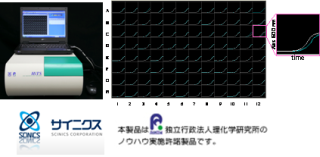p38 MAP kinase inhibitor screening using transformed bacteria.
Outlines:
The p38 MAP kinase is the central stress signaling molecule regulating the cellular response to a multitude of external stimuli. Thus, p38 inhibitors are postulated to have significant therapeutic potential. We have established a simple and economical inhibitor screening method for a human p38 by using growth recovery of the expression plasmid transformed bacteria as an index.
In our research, we observed that His tagged human p38 protein expression in E. coli BL-21results in its growth retardation. We applied this phenomenon for the inhibitor screening of p38 MAP kinase. Screening efficiency was optimized by introducing a convenient incubation micro plate reader, HiTS (Scinics Corp. Japan) which monitors the bacterial growth in the 96 wells by measuring absorbance and draws the growth curve automatically. Since many compounds that have intrinsic toxicities to the host bacteria and sometimes they become a noise for the screening, detection of growth recovery rather than inhibition is a major advantage of this method. Using this method, chemical libraries from RIKEN NPDepo (Japan) were screened for the p38 inhibitor and some new compounds were identified as promising candidates. The rationale of this screening method with transformed bacteria (named Bac. to the Future) may be applicable for the wide variety of the proteins.
|
Bacterial growth rescue by p38 kinase inhibitor 
p38 inhibitor rescued His-p38 expression plasmid transformed bacteria from growth retardation dose dependently. This phenomenon was applied for p38 MAP kinase inhibitor screening method. |
Optimizing inhibitor screening method  A newly developed incubation plate reader “HiTS” to optimize the screening method (left) and a typical picture of the screening result (right). |
References:
-
K. Kawai, A. Saito, T. Sudo, H. Osada.
A p38 mitogen-activated kinase inhibitor screening method using growth recovery of Escherichia coli as an index.
Anal. Biochem., 388, 128-133 (2009).


